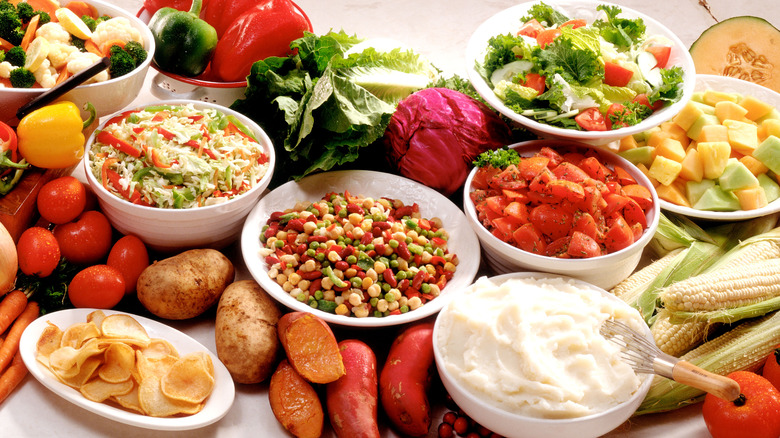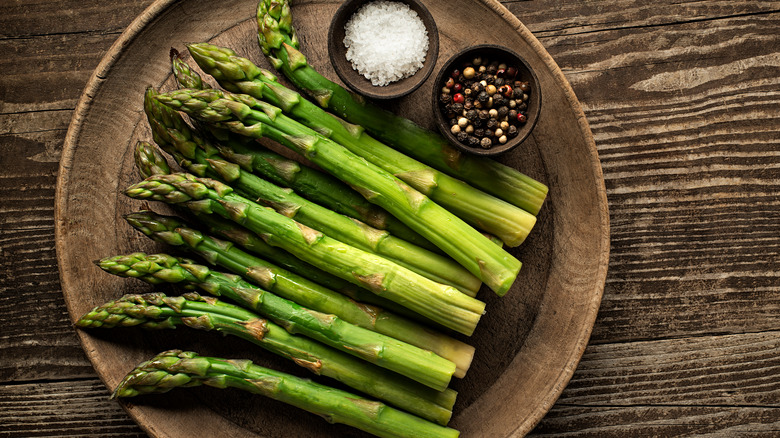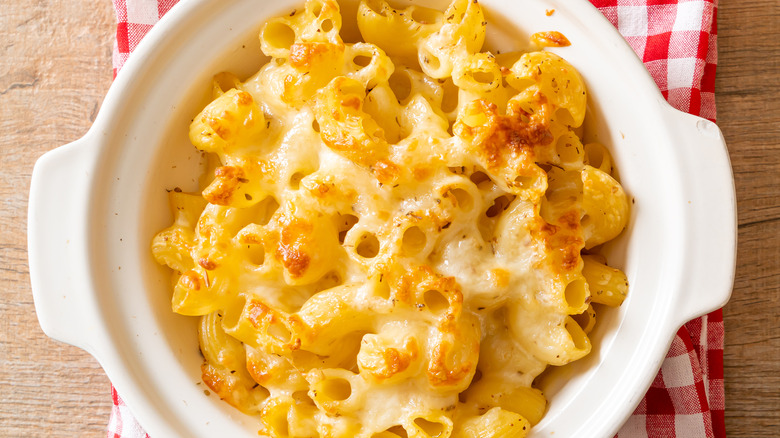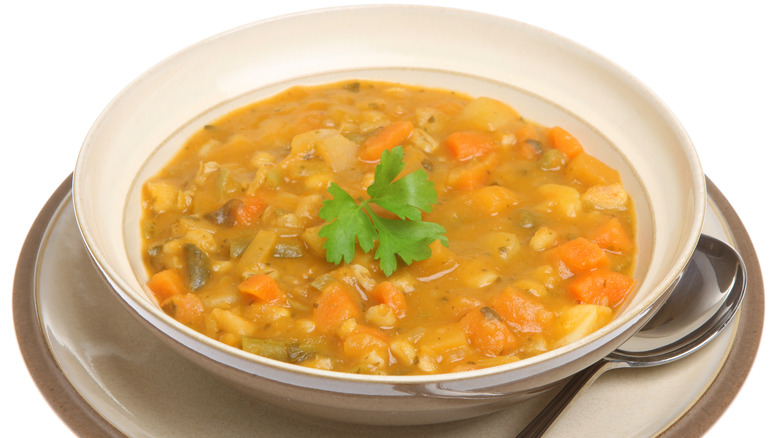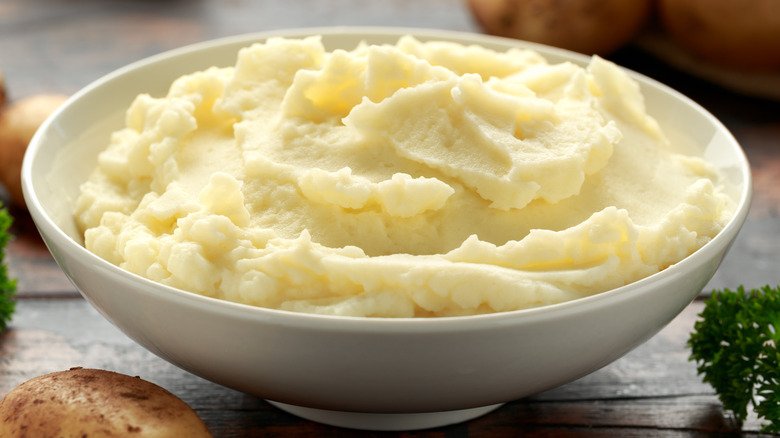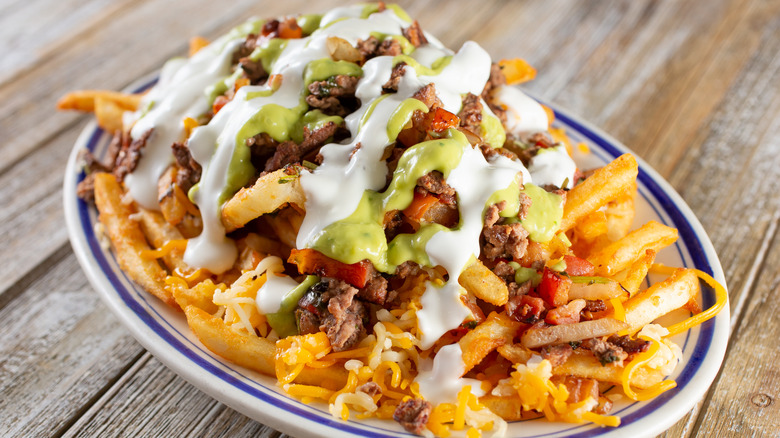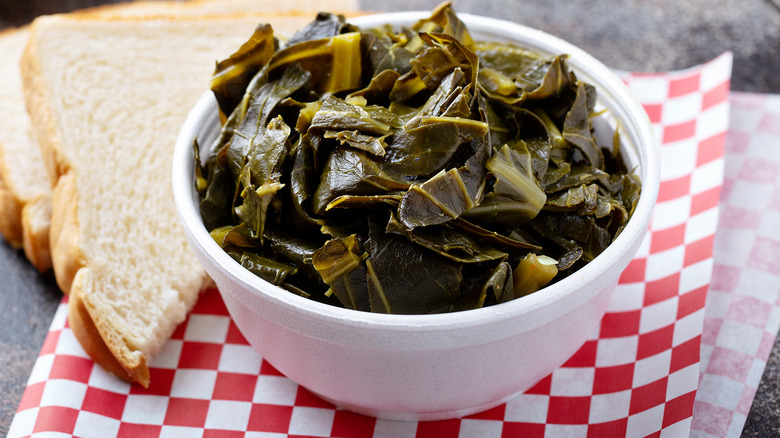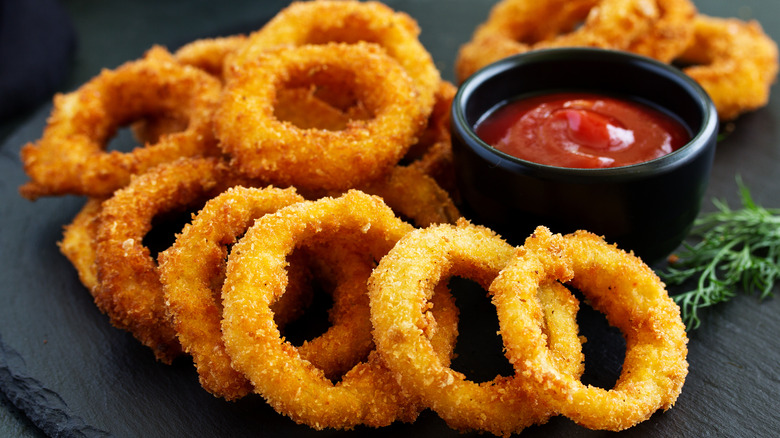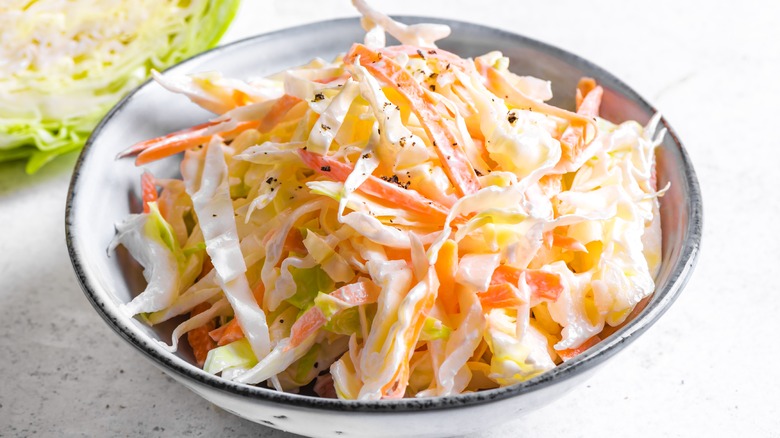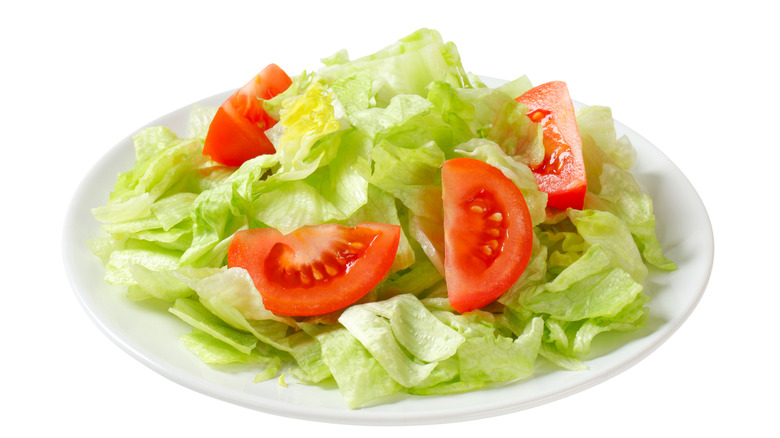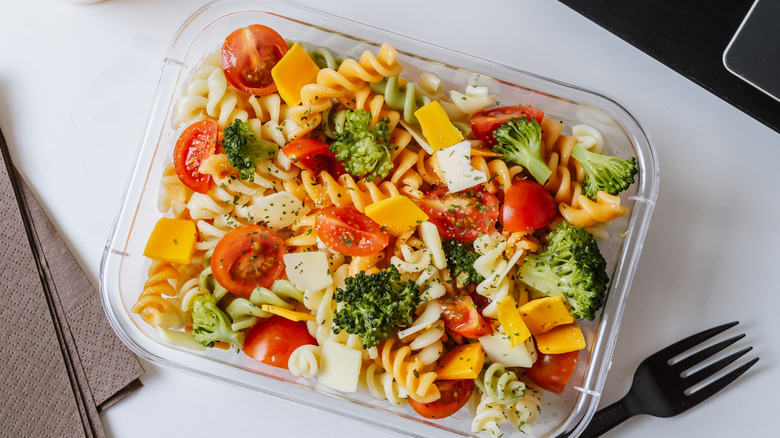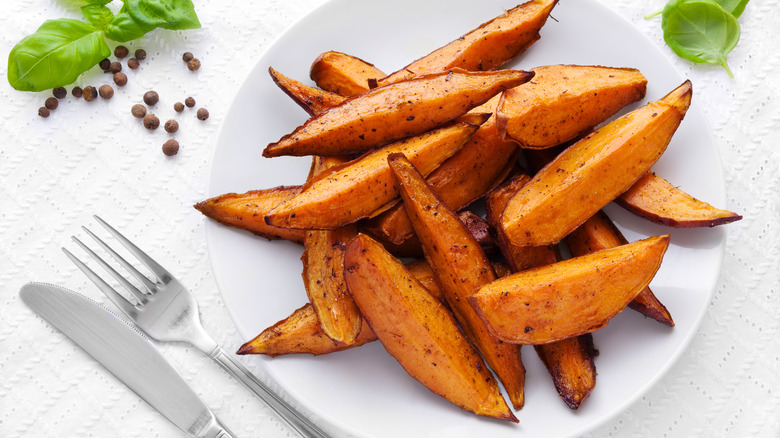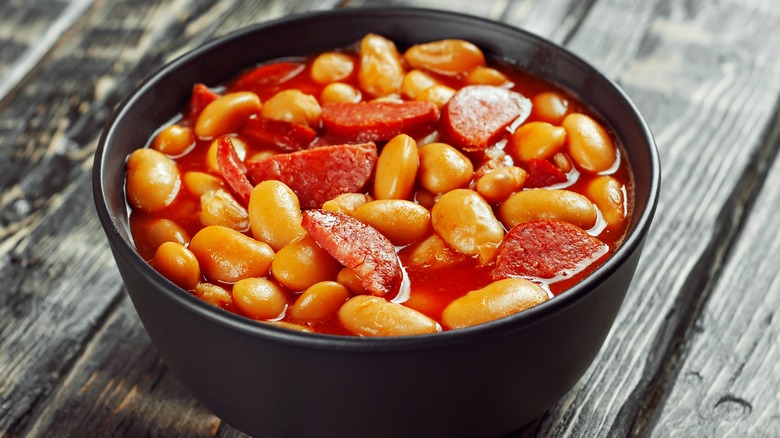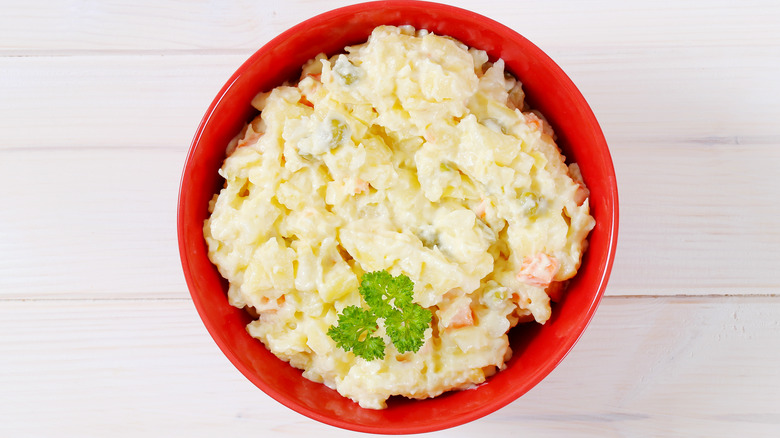13 Sides You Should Always Avoid At Restaurants
Restaurant sides can make or break your dining experience. A restaurant that has universally good sides is more of a rarity than a rule. The side dishes at a restaurant should be as good as its main courses, but many restaurants don't put as much effort into them. It's disappointing to spend money on a nice meal only to end up with sides that are warmed up from a can, endlessly recycled, or just disgusting. You'll wish you made a different choice if you end up with reconstituted mashed potatoes, strange-tasting coleslaw, bitter collard greens, or the wrong type of potato salad. And if you're a vegetarian or vegan who ends up only eating sides from a restaurant that can't be bothered to offer non-meat main courses, bad side dishes can ruin your entire meal.
The sides you should avoid at restaurants aren't just about getting dishes that taste bad. Sometimes, the reason for avoiding certain sides is prioritizing where you're spending your calorie, fat, and sodium quota for the day. For example, a serving of macaroni and cheese or loaded fries at some restaurants can provide as much nutrition as you need for an entire meal or even an entire day.
It can be tough knowing which sides to avoid, especially at a restaurant that's new to you. Once you know the dishes that are the most likely to be poorly prepared, or that can ruin your meal from an overabundance of calories, you can make better choices.
Asparagus
Asparagus is one of those vegetables that can be polarizing, depending on how it's prepared. Professional cook Keith Dresser at Cook's Illustrated is sure that the best asparagus is overcooked and mushy. However, some people prefer it when it remains crisp. In fact, if you think you don't like asparagus, it's probably because you don't like the way it's been cooked (via Reddit). Without knowing exactly what you're getting, choosing asparagus as your side at a restaurant can be risky. Will you end up with slimy, mushy asparagus or one that still has lots of snap left in it?
Of course, eating asparagus also causes an unpleasant side effect for most people – urine with a strong smell, similar to rotten cabbage. This scent comes from your body metabolizing asparagusic acid (a sulfurous compound specific to asparagus). If you experience this effect, you will notice the smell in your urine as soon as 15 to 30 minutes after eating the asparagus, and studies show that the effect can last up to 14 hours (via Healthline).
Macaroni and cheese
You would think that getting macaroni and cheese in a restaurant would be a safe bet. Sadly, it can be a big disappointment. Even well-known restaurants like Applebee's and Panera have disappointing macaroni and cheese sides (via Reddit). There are a lot of mistakes cooks can make with mac and cheese. Too often, the dish comes overcooked or flavorless from using the wrong type of cheese or no seasoning. Even more disappointing is when you realize the restaurant is using ordinary Kraft Macaroni and Cheese that you could have made for yourself at home.
If you do get a tasty mac and cheese at a restaurant, it's often ridiculously laden with fat, calories, and sodium. For example, a serving of Outback Steakhouse's mac and cheese has 720 calories, 37 grams of fat, and 1010 milligrams of sodium. Assuming you order mac and cheese and nothing else (which is not likely), you will have already consumed about half the amount of calories, fat, and sodium you should be eating the whole day on a 2000-calorie diet (via USDA).
Soup of the day
Some restaurants showcase a new soup or two on their menu daily, sometimes on a regular rotation. However, in many restaurants, ordering the soup of the day is a big gamble. A former restaurant owner said that, often, the soup of the day contains leftovers and veggies that are in unsellable shape (via Quora). The other main reason is that you have no idea how long the soup pot has been simmering or how many days that same vat of soup has supposedly been the "soup of the day." Many kitchens keep reheating the soup to sell until it's all gone (via Reddit). Celebrity Chef Gordon Ramsay says to always "ask what yesterday's soup du jour was before today's special. It may be the case that it's the soup du month" (via Town & Country). Soups often taste better on the second day, but nobody wants a mystery soup that's been aging and being recycled onto the menu for days on end.
Mashed potatoes
If you know that a restaurant makes its mashed potatoes from scratch onsite, it can be one of the best things on the menu. However, more often than not, you'll find that restaurant mashed potatoes are flavorless and made with reconstituted potato flakes. You may be disappointed to learn that even KFC's mashed potatoes come from a mix (via Newsweek). But if you're getting mashed potatoes from a fast food restaurant, it's less logical to assume the cooks have time to peel potatoes, boil them, and mash them by hand.
Whether the mashed potatoes are "real" or not, there's always the chance of the restaurant adding a weird gravy over the top that ruins the whole dish. For example, Popeye's uses a spicy Cajun gravy that isn't to everyone's liking, and Church's serves its mashed potatoes with a tangy and almost sweet gravy that can be confusing if you've never had it before (via Insider). If the possibility of instant mashed potatoes and questionable gravy isn't appetizing, skip the mashed potatoes.
Loaded fries
Loaded fries are loaded with more than just ingredients; they're full of calories, fat, and salt. Some orders of loaded fries are worse than others. For example, if you get a large order of chili cheese fries from Sonic, you are consuming 710 calories, 40 grams of fat, and 1390 milligrams of sodium. So your loaded fries side order could cost you close to half of your nutritional allowance on a 2000-calorie diet (via USDA). And Sonic's chili cheese fries aren't even the most outrageous loaded fries in terms of nutrition. If you get the loaded fries at Twin Peaks, they have 1320 to 1660 calories, 103 to 133 grams of fat, and 3210 to 5750 milligrams of sodium. That's the equivalent of multiple unhealthy meals. If you can't resist getting loaded fries at a restaurant, it's probably a good idea to plan to share with others so that you can still afford the calories in your main meal.
Collard greens
It's difficult to find a restaurant that can properly prepare collard greens in the authentic southern style (via Reddit). If you're not eating collards in the southern United States or at a soul food restaurant, you should probably just avoid them. One of the biggest problems with collard greens is that not everyone knows how to cook them. If a restaurant thinks they can cook them the same way as other more familiar greens like spinach or kale, they tend to end up with bitter, unpalatable collards. To get rid of the bitter taste in collard greens, it's necessary to cook them for as long as two hours. If they're still too bitter, adding salt and an acid like vinegar can help (via LeafTV). So if you do find yourself with a dish of bitter collards at a restaurant, you may still be able to save it somewhat with salt and a little hot sauce or pepper vinegar.
Something you might not expect when you order collard greens is that most collard recipes call for a lot of meat. So you shouldn't expect it to be a vegetarian menu item. And the meat additions are often ham hocks or other fatty, salty meats that increase the side's calorie, fat, and sodium content. Even if a restaurant uses turkey instead of pork, the dish has around 153 calories, 8 grams of fat, and 796 milligrams of sodium.
Onion rings
Onion rings are hit-or-miss (normally miss) when it comes to flavor. Sometimes you'll find yourself blindsided by the crust, which can range from savory to sweet. Some restaurants choose to dredge their onions in batter, while others dredge them in crumbs. The restaurant may use unexpected ingredients in the batter, like buttermilk or beer for the crust. A Sonic employee even revealed that the secret ingredient that Sonic puts in its onion ring batter is the vanilla ice milk mix they use to make their ice cream (via Copykat).
It also turns out that not every restaurant uses actual rings from onions when making their onion rings. Instead of real onions like you'd expect, Burger King shapes seasoned, dehydrated onions and onion powder into breaded rings (via Fooducate). So when you order onion rings from a restaurant, there's always the chance that what you think you're getting is not what you're actually getting.
Something else to consider before ordering onion rings as your side is how many calories they have. A large order of Sonic onion rings will cost you 800 calories, 39 grams of fat, and 790 milligrams of sodium. And since they have ice cream in the batter, they also provide 26 grams of sugar.
Coleslaw
Coleslaw is one of the most unpredictable side dishes you can order from a restaurant. More restaurants make coleslaw wrong than make it right. Yes, they all make coleslaw differently, and that's part of the problem. There's no gold standard for coleslaw, so you never know if you're going to get the type you like or not. Will they use vinegar or mayonnaise? Will they add sugar? Mustard? Shredded or chopped veggies? Horseradish? Will it be chunky or shredded? One Redditor said, "I am compelled to try every ... coleslaw I come across at restaurants, grocery stores, and delis. And I've never really had good coleslaw at a fast food place. Better off just grabbing a bag of cole slaw mix at the supermarket and a jar of Marie's coleslaw dressing."
One of the coleslaw mistakes restaurants sometimes makes is trying to use it too many days in a row. Coleslaw tends to go bad after three or four days, so if the restaurant coleslaw you get has a color or smell that seems off, you won't want to eat it (via Does It Go Bad).
Side salad
Sometimes the saddest, most disappointing side you can get at a restaurant is a side salad. The least satisfactory ones are nothing but a plate of lettuce with a colorless slice of tomato on top. And there's always the chance that the salad could come swimming in salad dressing as well.
Lackluster side salads are so much the norm that it's usually surprising if you end up getting a good one. One restaurant cook on Reddit said that unless you order a specialized salad or are getting a salad in a high-end restaurant, the cooks really aren't likely to pay much attention to making you a good side salad. The cook also said that you're likely to get unwashed produce in the salad and, if the restaurant pre-makes the side salads, the salads are likely to have been sitting around for hours. Another Reddit cook said that they once worked at a place where they made salads days rather than hours ahead. So there's a reason that many side salads make it to your table looking fairly unappetizing. They're just not something most restaurants think much about.
Pasta salad
Pasta salads have the potential to be amazing, with so many combinations for them to go well. Unfortunately, far too many restaurant pasta salads end up looking like someone started making a potato salad and decided to substitute macaroni pasta for the potatoes. Some of the biggest pasta salad mistakes restaurants make come from not salting the water while cooking the pasta, overcooking the pasta, or using the wrong type of noodles (via Today).
Chef Samin Nosrat says that salt makes everything taste better because it is a flavor enhancer. How much salt do you really need for pasta water? Nosrat suggests cooks add a whole palmful of salt when boiling water for pasta (via YouTube). Without salted pasta, the salad will taste bland.
Overcooking pasta causes the noodles to lose nutrients like vitamins and amino acids. Overcooking also breaks down more sugars to give the pasta a higher glycemic index, which can result in you feeling hungry again soon after eating (via Livestrong).
Nothing's worse than getting a pasta salad with pasta that has the wrong mouthfeel. Foodies told Mashed that their favorite type of pasta for pasta salad was corkscrew-shaped rotini pasta, winning 28.48% of the vote. The second- and third-place winners were penne and elbow macaroni, while other pasta shapes didn't get many votes at all. When HuffPost talked to professional chefs about the shapes they tended to use, they opted for ones with "curves to catch the dressing."
Deep-fried veggies
Deep-fried veggies are deceiving. We can fool ourselves into thinking we're ordering a healthy restaurant side dish; however, deep-fried okra, sweet potatoes, squash, green tomatoes, and other veggies lose their healthful status when they're battered and fried in hot oil.
Weight-loss advisor for Women's Health Keri Glassman, M.S., R.D., says that "Healthy fat ... has an essential role in your diet." There's really no chance that your deep-fried vegetables are being fried in healthy oil, even if they deep fry with a "good fat" like olive oil. Another problem with deep-fried vegetables is that the deep-frying process removes a lot of the vitamins and minerals that make vegetables healthy in the first place.
Choosing veggies can be a healthy choice for a side dish as long as they're boiled, steamed, or sautéed in olive oil. The difference between sautéing and frying is whether the restaurant is submerging them in oil or lightly cooking them in a pan in a small amount of oil. Deep frying takes longer, so it also causes the vegetables to absorb more bad fat (via Healthline).
Baked beans
Baked beans are another hit-or-miss restaurant side item. Some restaurants just open up a disappointing can of baked beans and call it done. However, not all canned baked beans are created equally. Similarly, not all restaurant baked beans are equal either. In fact, we'd bet you've been dissatisfied more times than you've been wowed by getting baked beans as a side dish. Chances are that if you end up getting good baked beans as a side, they'll be chock-full of calories, fat, and sugar.
Baked beans have the potential to be a healthy dish. Since restaurants tend to make baked beans from navy beans, they offer a wide range of nutrients, like thiamine, zinc, selenium, and fiber. However, a half-cup serving of baked beans typically contains 20% of your daily sugar limit and 19% of your daily salt limit (via Healthline). And if the restaurant adds a lot of meat to the dish, there's a potential for it to be extremely fatty.
Choosing baked beans as your side also has the potential to make you gassy for the rest of the night. Healthline says that beans contain indigestible fiber and carbs that ferment in your intestines, often leading to a gas-filled evening. So at a restaurant on a date, you'll want to think twice before choosing baked beans as a side, even if you know the restaurant has good baked beans.
Potato salad
A Reddit thread that asked people to express their strong feelings about potato salad ended up with 452 comments because there are just so many ways you can ruin potato salad. Everyone seems to have their favorite kind, such as German potato salad, Russian potato salad, loaded potato salad, or Amish potato salad. With so many types of potato salad in the world, flavor component must-haves vary from mustard to mayonnaise, vinegar to sour cream.
Hate runs rampant among some regarding hot potato salad, potato salad with undercooked potatoes, or sweet potato salad. Some people think boiled eggs, onions, celery, or relish are a must, while others despise these ingredients. If there's mayonnaise, the type people use for potato salad also seems to matter, with people expressing extreme dislike for Miracle Whip rather than real mayonnaise, and others swearing by Duke's mayo. With all these specific parameters for the perfect (or imperfect) potato salad, it's no wonder that restaurant potato salad is often better avoided. The truth is that some people only like their mother's potato salad and would never be happy with restaurant potato salad unless their mom was the head chef.
Something else to consider is just how many calories and fat a side of restaurant potato salad can have. For example, a serving of KFC's potato salad has 340 calories and 28 grams of fat, which equates to half of your daily fat intake for a 2000-calorie diet (via Mayo Clinic).
